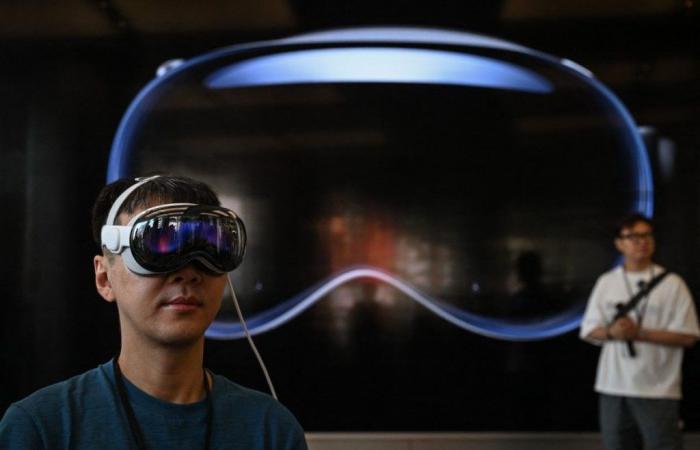A customer tries on the Apple Vision Pro mixed reality headset during the product launch at the Apple Store in Beijing on June 28, 2024.
Atlantico: Apple has officially opened pre-orders for its first mixed reality headset, the Vision Pro, in France and certain European countries. The models will be available from July 12 in France after a launch last February in the United States. What are the advantages of the Vision Pro and what are its main characteristics? What is this technology? Does this helmet have any defects or possible flaws?
Gilles Dounès : Indeed, after an initial launch in the United States on February 2, in mainland China, Japan and Singapore this Friday, June 28, Apple launched pre-orders for its “big” Anglo-Saxon markets (Australia, Canada) and its Western European market (Germany, France, United Kingdom) this Friday as well, with effective availability once again in two weeks, on Friday, July 12.
In this case, it is truly the “state of the art” of virtual reality headsets – in this case mixed reality – that Apple is starting to roll out little by little. As usual, the Cupertino firm has relied on the combination of its expertise in software and user interface, with the integration of high-end, even very high-end hardware components. Particularly in terms of display, with a 3D system based on two Micro-OLED screens for binocular vision and a total of 23 million pixels. Other decisive advantages of the Vision Pro are the “in-house” chips designed by Apple and manufactured by TSMC.
Unlike the first virtual reality headsets, which simply displayed virtual images calculated by the device, “mixed” reality headsets combine the display of images of the environment of the wearer of the headset, in the manner of a hybrid camera viewfinder for example, with virtual reality images calculated by the headset. The main M2 chip, that of the previous generation of MacBook Pro, manages the computer calculations and the display of the two screens in 4K, while the R1 chip integrates the data streams generated by the dozen internal or external cameras, five sensors and six microphones. Two side cameras and two downward-facing sensors constantly capture hand movements and position for a gesture-based user interface, a la “Minority Report”.
We can thus navigate between windows, objects, resize them, move them: this is what Apple calls spatial computing. The paradigm level abstracts from the defined frame of the screen, however large it may be, and allows us to work, to think differently, by manipulating the concepts, the ideas “contained” in the windows, considered as so many “containers of thoughts” presented on the entire field of vision.
However, the Vision Pro is not a miracle product and must be considered for what it is: the first original formulation of a concept, of a new paradigm in the realization necessarily depends on a compromise that results from the advancement of electronic components that are available at a given time T… And from the advancement of potential competitors. Unlike its autonomous car project, Apple considered that it was possible to propose its industrial project to the market.
Concretely, on a material level the headset itself is heavy to wear, beyond a few tens of minutes, especially since it is made with good quality materials. Even its “double-layer” interface, with two additional screens oriented towards the outside of the helmet and which allows those around them to “see” the expressions of the wearer of the helmet, ultimately contributes to this discomfort often reported by testers and users, once the initial enthusiasm has dissipated. Airtight – the “sealing shell” is the subject of a reasoned choice when ordering – can cause discomfort with a feeling of excessive temperature. Paradoxically, the Vision Pro also suffers from the limited autonomy of its external battery of 2 hours to limit the weight of the headset, and which is sometimes annoying when you want to move around with the headset on your nose.
From a software point of view, the vision OS operating system and the user interface are only in their early stages, although of course they are likely to evolve and improve constantly: the WWDC of the beginning of the The month of June allowed us to present the improvements to the interface and the feeling of immersion, improvements which will be available in the fall, with Vision OS 2.0.
Is this headset offered by Apple a high-end model? Is its budget substantial? Is it much more expensive than the competition on the market like the Meta Quest 3 or compared to a virtual reality headset?
Traditionally, when it attacks a market, Apple systematically aims for the top of the spectrum, both in terms of technology and pricing, even if it means declining its vision in a more accessible way, increasingly towards a wider audience. Although in this case, Apple seems to have made efforts to moderate its augmented reality headset: this was already the case for the American market, according to some usually reliable sources, but it is indeed the case for the European market. With a tax-free price of $3,500 at the entry level for the American market, we feared a “painful” price of around €4,500 including tax in Europe and France, in particular.
However, this is not the case: the Vision Pro is priced at €3,999 for the entry-level version with 256 gigabytes of storage, €4,249 for the 512 gigabyte storage version and €4,499 for the 1 TB version. For comparison, the Meta Quest 3 is offered at a price of €549, but with an essentially playful vocation, fewer sensors and a “plastic” finish, which is significantly less durable. Another advantage for the Vision Pro, Apple offers on the Vision Store no less than 2000 native applications specially developed for the platform, and 1.5 million “compatible” applications from the iOS or iPadOS catalog.
Perhaps the comparison could have been most relevant with Microsoft’s HoloLens, for its professional uses, but the Redmond giant announced at the end of last year that they were abandoning its manufacture.
Why is this mixed reality headset generating so much interest? What are its main uses and most innovative features? How is it revolutionary compared to virtual reality headsets?
Very cleverly, Apple was able to generate interest with the general public uses of its immersive interface: with photos, cinema, series. But it is not to extract more money from its first-time buyers that Apple has attached the suffix “pro” to its virtual reality headset: it is truly intended for professional uses, even if recreational uses, recreational, are also present and highlighted by Apple to capture attention.
Apple’s native applications, supplied with all its platforms, of course benefit primarily from its innovations in interface and immersion, Safari, Mail, Photo, FaceTime, Notes, but Apple’s historical competitors were not mistaken. Upon launch in the United States, Microsoft announced the porting of Office 360 and Teams to the new platform. And Adobe did the same for LightRoom. Apple also recently offered a version of Final Cut Pro dedicated to the platform.
Once again, this is a real paradigm shift, but if we had to sum it up in one word, what is undoubtedly revolutionary is this ability to integrate digital content into the user’s physical space, and which literally “sticks” the user when they put on the Vision Pro.
Does this headset have benefits for entertainment, communication and work or is it best used in certain areas only?
Of course, Apple has not deprived itself of initiating general attention with entertainment. Watching movies, series or documentaries is an amazing experience as it immerses the user in the work presented, and communicating with Zoom, Teams or FaceTime. All of this can also represent a welcome break in a workflow, a break that can revive creativity and productivity.
But in this first version, the Vision Pro is probably primarily intended for professionals. Moreover, they did not wait for the availability of the Vision Pro on the French market to take an interest in it, and even to launch into the production of specific applications for the new platform. This is the case of Decathlon, whose application was cited as an example by Apple, but also for a significant portion of French companies.
A study in April 2024 conducted by www.sortlist.fr with a thousand French business leaders, showed that 64% of them were ready to invest in creating immersive experiences with the Apple Vision Pro, in a range of €10 to €30,000, primarily in virtual demonstrations of their catalog. The sectors most interested in immersive experiences with the Apple Vision Pro are e-commerce (78.9%), fashion (77%) and healthcare (72%).
But the potential is perhaps even greater represented by specifically “business” applications, such as eXeX, which enabled a London surgical team to carry out a real surgical procedure on a patient’s spine, by simultaneously presenting the real surgical field data along with procedure guides and other contextual data in virtual windows. Apple’s headset was described on this occasion as a “game changer”, reducing uncertainty and eliminating human errors.






